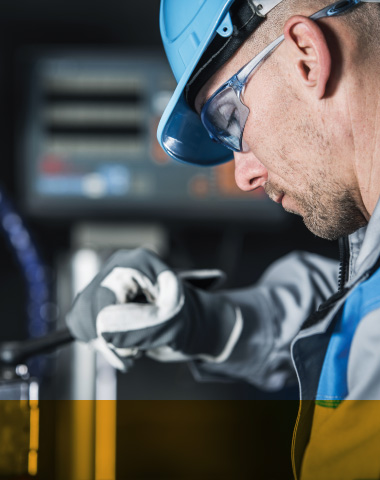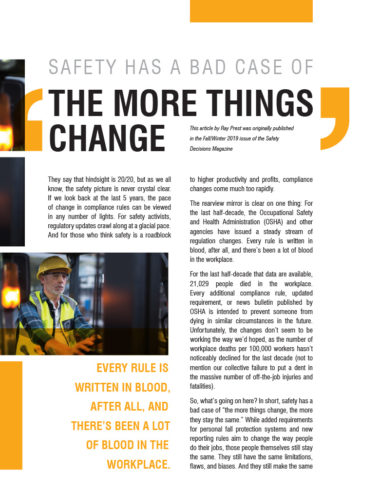This article by Ray Prest was originally published in the
Fall/Winter 2019 issue of the Safety Decisions Magazine
They say that hindsight is 20/20, but as we all know, the safety picture is never crystal clear. If we look back at the last 5 years, the pace of change in compliance rules can be viewed in any number of lights. For safety activists, regulatory updates crawl along at a glacial pace. And for those who think safety is a roadblock to higher productivity and profits, compliance changes come much too rapidly.
The rearview mirror is clear on one thing: For the last half-decade, the Occupational Safety and Health Administration (OSHA) and other agencies have issued a steady stream of regulation changes. Every rule is written in blood, after all, and there’s been a lot of blood in the workplace.
For the last half-decade that data are available, 21,029 people died in the workplace. Every additional compliance rule, updated requirement, or news bulletin published by OSHA is intended to prevent someone from dying in similar circumstances in the future. Unfortunately, the changes don’t seem to be working the way we’d hoped, as the number of workplace deaths per 100,000 workers hasn’t noticeably declined for the last decade (not to mention our collective failure to put a dent in the massive number of off-the-job injuries and fatalities).
So, what’s going on here? In short, safety has a bad case of “the more things change, the more they stay the same.” While added requirements for personal fall protection systems and new reporting rules aim to change the way people do their jobs, those people themselves still stay the same. They still have the same limitations, flaws, and biases. And they still make the same mistakes that lead to serious injuries and fatalities, regardless of what the health and safety rules say.
Every rule is written in blood, after all, and there’s been a lot of blood in the workplace.
 But you can’t blame the workers for injuries caused by human error. Like computers, human beings are only as powerful as their operating systems. And unfortunately, we haven’t had a significant update to the way our brains and bodies work in thousands of years. Our daily life may look a lot different from that of our great-great-great-grandparents—and I know our personal protective equipment (PPE) is a lot better—but we still get tired, distracted, and overconfident just like they did. If we want to keep workers safer, we need to help them better understand their own limitations.
But you can’t blame the workers for injuries caused by human error. Like computers, human beings are only as powerful as their operating systems. And unfortunately, we haven’t had a significant update to the way our brains and bodies work in thousands of years. Our daily life may look a lot different from that of our great-great-great-grandparents—and I know our personal protective equipment (PPE) is a lot better—but we still get tired, distracted, and overconfident just like they did. If we want to keep workers safer, we need to help them better understand their own limitations.
But it’s not just errors—people are continually up against a wide array of subtle variabilities in their actions, and publications like this one have done a great job of getting the word out about the dangers of human factors. More than ever, safety professionals recognize the need to reach out beyond compliance in order to help workers avoid injury by paying more attention to what they’re doing.
In the past 5 years, many compliance rules have changed. At our current place on the historical arc of workplace safety, we’ve managed to eliminate the vast majority of injuries that were caused by unsafe conditions or sloppy rulemaking. But in doing so, we’ve picked all the low-hanging fruit. For the next 5 years and beyond, we need to turn our attention to higher branches.
One positive trend I’ve noticed is that safety executives increasingly understand the problem. They recognize the safety challenges that are built into humans’ internal operating systems. A decade ago, people rolled their eyes every time we said the words “human error.” Now, heads nod in agreement.

One of the big themes throughout my columns has been building a consensus on the need to address the human side of the equation. More safety folks (and nonsafety executives, too) continue to jump on the bandwagon, and organizations like the National Safety Council (NSC) and numerous academics worldwide are examining and quantifying the pervasive influence of human factors.
There are all sorts of different paths to improving reliability in human performance, but the road map is often unclear.
Now, we need to decide what we’re going to do with this knowledge. This is where things get murky. There are all sorts of different paths to improving reliability in human performance, but the road map is often unclear.
While hindsight can be a powerful tool for change moving forward, it’s not without its blind spots. Hindsight bias is the human tendency to believe that events that have occurred were more predictable than they were. This can lead to a general overconfidence in our ability to foresee the future. Ironically enough, this makes us less likely to learn from the past and contributes to a collective sense of “the more things change.” We must admit what we don’t know—and then work together as an industry to develop more practical approaches to mitigating the effects of human error.
To that end, I think the trend from the past 5 years will be the same for the next 5 in many regards. Government agencies and legislators will continue to churn out updates and additions to compliance requirements, but many of these will lag behind the pace of technological advancements.
Smart organizations will keep pace with these updates and compliance requirement additions while focusing the bulk of their efforts on building organizational resilience. Really smart organizations will think about their workers’ well-being beyond the workplace while experimenting with novel approaches to curbing human factors. This means creating work environments that account for the vagaries of human workers and establishing management systems and organizational structures that learn from employees’ on-the-ground experience.
Most of all, businesses will continue the trend in developing human capacity. The sheer cost of labor (not to mention the financial impact of workplace incidents and the moral imperative to do the right thing) will drive companies to improve workers’ mindfulness, strengthen their ability to pay attention, and give them the transferable skills and knowledge to recognize and reduce risk not only in the workplace but also in their personal lives.
 They say the only constant is change, so taking a 24/7 view of safety will inevitably follow a focus on personal safety, as that’s where most employees’ personal risks exist—at home and on the road. But a company’s speed of adoption will be either slow with a passive approach or quick with a deliberate pursuit. And ultimately, that will be influenced by you.
They say the only constant is change, so taking a 24/7 view of safety will inevitably follow a focus on personal safety, as that’s where most employees’ personal risks exist—at home and on the road. But a company’s speed of adoption will be either slow with a passive approach or quick with a deliberate pursuit. And ultimately, that will be influenced by you.
Change and improvements of any kind aren’t easy. It takes time, a broad understanding of human behavior, research and analysis, professional development, business case development, change management plans, and a whole lot of effort. Safety is hard, and changing people is even harder—but keeping your hard-working people safe is worth the effort, so keep moving forward in the important work you do.
If you’ve been following my column all along, you’re already familiar with my human factors’ flag-waving, and I thank you not only for your readership but also for your shared concern for people and your desire to constantly improve. If you haven’t hopped on the beyond-compliance bandwagon yet, it’s time to catch up because human capacity won’t change on its own—especially with a workplace-only safety perspective.
I’d like to use this closing paragraph to congratulate the folks at Safety Decisions on their fifth anniversary. It’s challenging to publish a single issue of a magazine, let alone almost 20 of them! But everyone at EHS Daily Advisor and Safety Decisions does an incredible job of putting out a first-class product. I’m thankful to be able to contribute to their publication every quarter, and I hope you’re as excited as I am to see what they have in store for the next 5 years!
Ray Prest is the Director of Marketing at SafeStart, a safety company focused on human factors solutions that reduce preventable death and injuries on and off the job. A columnist for Safety Decisions since 2015, Ray’s been helping people learn about safety and training for over 20 years. Read more at safestart.com/ray.

Get the PDF version
You can download a printable PDF of the article using the button below.

